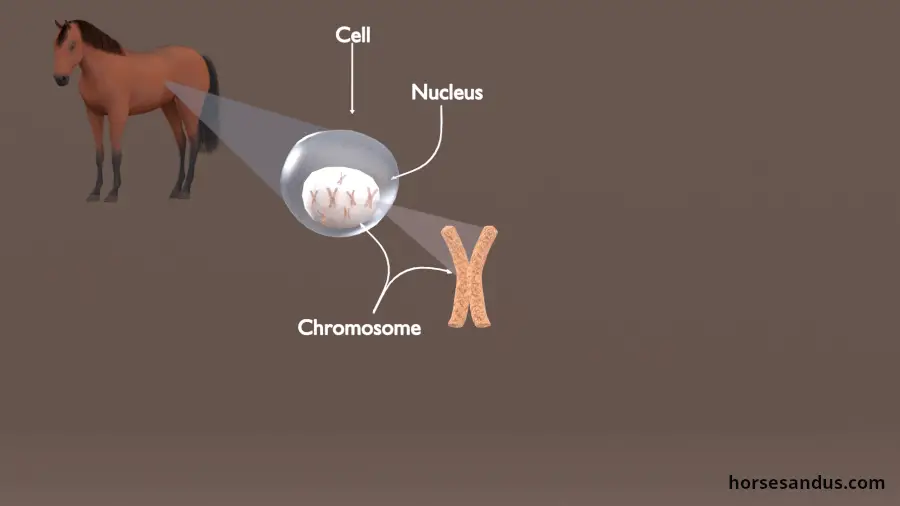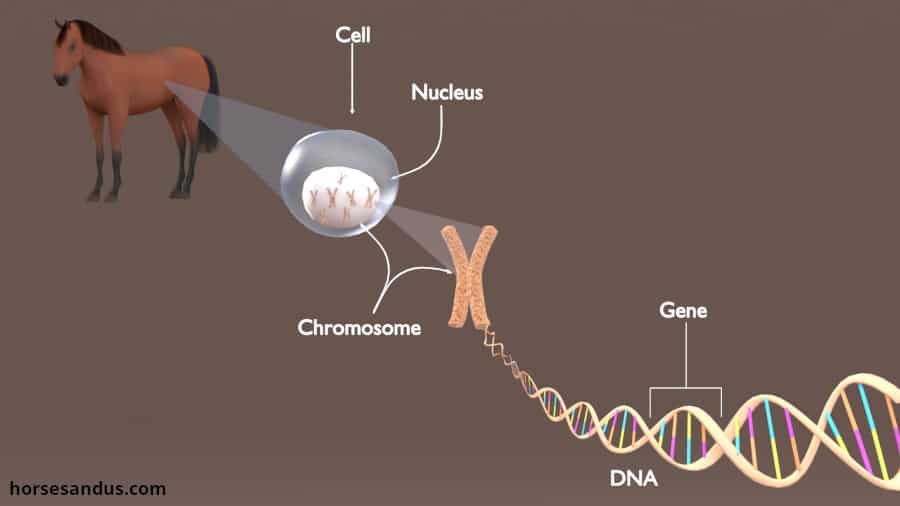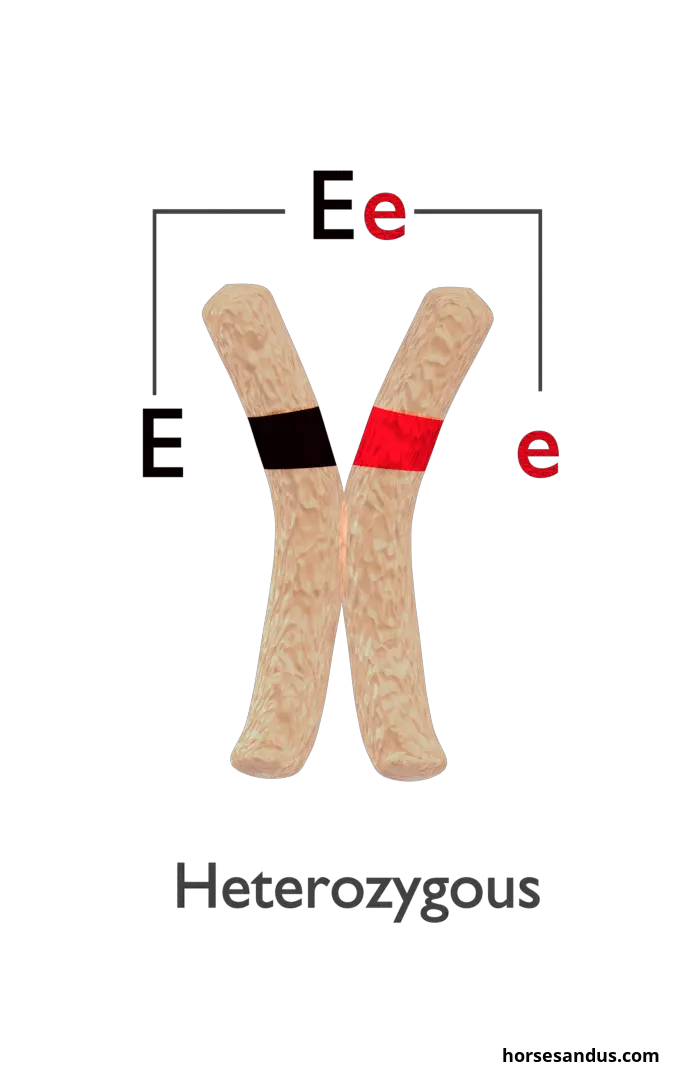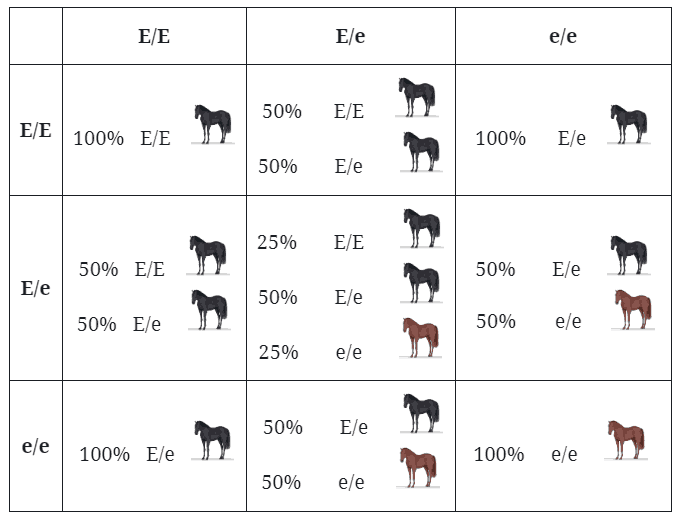Have you ever wondered why horses have so many different coat colors? Let’s solve this puzzle and find out if the parent´s coats hide the answer.
- Is it possible to predict the color of foals when certain mares and stallions are mated?
- Can we figure out ways to increase the chances of a particular color.
- Can we learn how to prevent unwanted colors or colors that might even have health risks?
In this article, we will explain how genetics can shape different coats.

This article is intended for those interested in horse colors and patterns but have no formal training in genetics. We will learn basic concepts about horse color genetics and inheritance.
Genetics can be challenging to understand, and one of the difficulties is related to the terminology used to discuss it. So we will start with some definitions.
Cells
The body of a horse is made up of trillions of cells. These are tiny structures and are the basic unit of living organisms. There exist many types of cells, like bone cells, muscle cells, skin cells, blood cells, nerve cells, and so on.

All the cells have the same set of genes. However, in each cell, different genes are turned on and off. This is what gives each cell a specific function.
So only a small part of the 20,000 genes of the horse are working at any one time in a particular cell.
Nucleus
Each cell has a nucleus. This is where the 64 chromosomes of the horse exist. There are 32 inherited from the sire and 32 inherited from the dam.

Chromosome
A chromosome is a rod-like body made up of DNA tightly coiled like a noodle. The chromosomes hold the genetic information together, protecting it from getting tangled and damaged.

DNA
The DNA contains the genetic information. It consists of two long chains of nucleotides coiled into a double helix, similar to a twisted ladder. The sequence of nucleotides is what determines the genetic code.

short animation
Gene
A gene, is a segment of the DNA which contains the information for a specific trait.
A single strand of DNA contains thousands of genes. Some genes are small segments, and others are very long segments, depending on the function it has on the body.
Locus
Each gene has an address, which is a specific location in the chromosome. This address is called locus (loci for plural). Often the locus name is used when referring to a gene.
Idiogram
Geneticists use diagrams called idiograms as a standard representation for chromosomes. Idiograms show a chromosome’s relative size and its banding pattern. These bands are used to describe the location (locus) of genes on each chromosome.

Allele
A gene can have different variations which are called alleles
An allele is responsible for the physical traits, whether these traits can be seen or not.
Since chromosomes come in pairs, each horse carries two alleles at a particular locus. One allele is inherited from the male parent and one from the female parent.

Homozygous
When an organism has two identical alleles (two copies of the same allele), it is said to be homozygous for that gene.
Let´s consider, for example, the Extension gene, which determines if a horse is black or red. A black horse may be homozygous dominant for the Extension gene (E/E), while a chestnut horse is homozygous recessive for that gene (e/e).

Heterozygous
If an organism carries one copy of each allele, it is considered heterozygous. For example, a phenotypically black horse may be heterozygous (E/e) for the Extension gene.

Genotype
A genotype is the genetic makeup of a trait, consisting of a specific combination of alleles. For example, there are three possible genotypes for the Extension gene, and they are E/E, E/e, and e/e.
Phenotype
Phenotype is the characteristic of an animal that can be seen or measured, for example, color, height, speed, and so on.
Not every allele that is present is always expressed. Some are masked by other alleles but can still be passed onto offspring.
Alleles can be expressed in different ways, and we will see three cases: dominant, recessive, and incomplete dominant.
Before we go any further, there is another concept that needs to be introduced, which is the convention that dominant alleles are represented with an uppercase letter and recessive alleles with a lowercase letter.
Dominant allele
Dominant alleles are expressed even if the horse has only one copy of the allele. So heterozygous will look the same as homozygous.
For example, the E allele for the black color is dominant. Horses will be black, whether they have two copies of the “black color” allele (E/E) or only one copy (E/e).
Recessive allele
Recessive alleles are only expressed when the dominant allele is absent. So only when the horse has two copies of the recessive allele.
For example, the allele for red color, e, is recessive, therefore to have a red coat color (chestnut), the horse needs to have two copies of the “red color” allele.
Incomplete dominant allele
Incomplete dominant alleles have a dosage effect, i.e., they will express with more intensity as more copies of the allele are present. So homozygous will be more intensely expressed than heterozygous.
For example, the Cream allele (CR) on a red base coat has the effect of lightening the coat color.
- When one copy of the allele is present (heterozygous), it dilutes the red to yellow.
- When two copies of the allele are present (homozygous), it will further dilute to cream.
We can explain the incomplete dominance with an example of the Cream gene on the chestnut color. Let’s consider that:
- cr represents the non-dilution allele
- CR represents the cream dilution allele
We can have three possible genotypes (cr/cr, cr/CR, CR/CR), each one with a different trait, which means we can have three possible phenotypes:
- If no Cream allele is present, we have the genotype cr/cr, and so the chestnut color will be expressed.
- If only one Cream allele is present, single dilute, we have the genotype cr/CR so that some dilution will be expressed. The color of the coat will be diluted to a reddish-gold hue. But there is still some visible pigment, and the skin and eyes retain the original color of the chestnut. Therefore we have a mixture of both traits (from cr and CR)
- If two copies of the cream allele are present, double dilute, we have the genotype CR/CR, and a full dilution will be expressed. The color of the coat lost almost all the pigment. The skin also, which is now pink, and the eyes are blue.

The Genetic Lottery
Horse genetics explains the transmission of characteristics from sires and dams to their foals. A foal inherits half of its alleles (a variant of a gene) from its dam and the other half from its sire. So it will have a combination of characteristics from both parents.
Punnett Square
Punnett Square is a genetic tool used to predict possible offspring based on the parents’ different genotypes.
We will exemplify how to use the Punnett square with the Extension gene, which determines if a horse is black or red (chestnut).
The dominant allele ‘E’ causes the horse to have black pigment (eumelanin) while the recessive allele, ‘e,’ causes the horse to have only red pigment (pheomelanin).
Scroll through the following Punnett squares to observe possible outcomes from the different combinations.





Inheritance Chart
We can also represent the possible outcomes using an inheritance chart:

As you can see, for any particular gene, a foal has a genotype that may be like that of one or the other parent or like neither of them
In the example above, we can see that two heterozygous black horses could have a foal that is non-black and is instead red.
On the other hand, two homozygous black horses could only ever have black foals when mated together.
Breeding together, a heterozygous black and a homozygous black would give only black foals, and breeding two red horses can only give red foals.
Genetic tests
For a long time, horse color genetics has been studied to determine coat color and pattern in horses. As the research in this area progresses, it is getting easier for the interested breeder to forecast the likely color and pattern of foals from breeding specific mares and stallions.
However, the genotype cannot always be determined from the observable color traits (phenotype). For example, a black horse could have either the genotype E/E or E/e.
In these cases, a genetic test can be performed on the sire and dam to provide further insight into the possible offspring coat colors.
Many tests are available and are very simple and cheap. You just need to pull some hairs from the mane or tail of your horse and send them to the laboratory. After the analysis is done, the results will be sent back to you.
Further Reading
The link below that leads to products on Amazon is an affiliate link and I earn a commission (with no additional cost for you) if you make a purchase.
If you would like to learn about equine color genetics, this book has excellent information.
Equine Color Genetics

